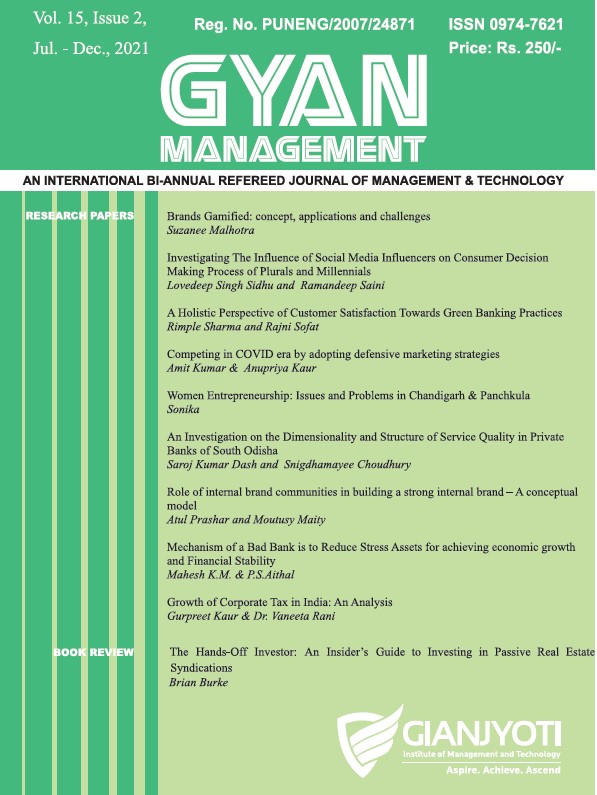Default Risk Prediction in Firms via Statistical Techniques – A review
DOI:
https://doi.org/10.48165/gmj.2023.conf6Keywords:
default risk prediction, discriminant analysis, logistic regressionAbstract
The current study presents the literature review of default risk prediction studies for the period 1930-2022. The rising corporate default is a reason of concern for banks and companies. It has particularly attracted the attention of researchers since the global crisis of 2008-09. The review is based on statistical techniques including discriminant analysis, multiple discriminant analysis, logistic regression, conditional logistic regression and probit regression. The review targets the following aspects of the studies: country origin, period of study, financial indicators used and accuracy of results. Analysis of review depicts that logistic regression (LR) is the most applied technique among statistical techniques to predict corporate failure. However, focus has now been shifting to intelligent techniques in 21st centuary.
Downloads
References
Agrawal, K., & Maheshwari, Y. (2019). Efficacy of indus try factors for corporate default prediction. IIMB Management Review, 31(1), 71-77.
Altman, E. I. (1968). Financial ratios, discriminant analy sis and the prediction of corporate bankruptcy. The journal of finance, 23(4), 589-609.
Bandyopadhyay, A. (2006). Predicting probability of default of Indian corporate bonds: logistic and Z‐ score model approaches. The Journal of Risk Finance.
Beaver, W. H. (1966). Financial ratios as predictors of fail ure. Journal of accounting research, 71-111.
Bhunia, A., & Sarkar, R. (2011). A study of financial distress based on MDA. Journal of Management Research, 3(2), 1-11.
Chen, M. Y. (2011). Bankruptcy prediction in firms with statistical and intelligent techniques and a com parison of evolutionary computation approaches. Computers & Mathematics with Applications, 62(12), 4514-4524.
Deakin, E. B. (1972). A discriminant analysis of predictors of business failure. Journal of accounting research, 167-179.
Doumpos M.; Zopoudinis C. (1999). A multicriteria dis crimination method for the prediction of financial distress: the case of Greece. Multinational Finance Journal 3(2): 71–101
Du Jardin, P. (2010). Predicting bankruptcy using neural networks and other classification methods: The influence of variable selection techniques on model accuracy. Neurocomputing, 73(10-12), 2047-2060.
FitzPatrick, P. 1932. A comparison of ratios of success ful industrial enterprises with those of failed com panies. The Certified Public Accountant (October, November, December): 598-605, 656-662, and 727- 731, respectively.
Grice JS, Dugan M (2001) The limitations of bankruptcy prediction models: Some cautions for the researcher. Rev Quant Finan Acc 17:151–165.
Gupta, P. K., & Jain, K. K. (2022). Credit default predic tion for micro-enterprise financing in India using ensemble models. Global Business and Economics Review, 26(1), 84-98.
Jo, H., Han, I., & Lee, H. (1997). Bankruptcy predic tion using case-based reasoning, neural networks, and discriminant analysis. Expert Systems with Applications, 13(2), 97-108.
Jones, S., & Hensher, D. A. (2004). Predicting firm finan cial distress: A mixed logit model. The Accounting Review, 79(4), 1011-1038.
Karels, G. V., & Prakash, A. J. (1987). Multivariate normal ity and forecasting of business bankruptcy. Journal of Business Finance & Accounting, 14(4), 573-593.
Kim, S. Y. (2011). Prediction of hotel bankruptcy using sup port vector machine, artificial neural network, logis tic regression, and multivariate discriminant analysis. The Service Industries Journal, 31(3), 441-468.
Lee, S., & Choi, W. S. (2013). A multi-industry bankruptcy prediction model using back-propagation neural net work and multivariate discriminant analysis. Expert Systems with Applications, 40(8), 2941-2946.
Lennox, C. (1999). Identifying failing companies: a re-evaluation of the logit, probit and DA approaches. Journal of economics and Business, 51(4), 347-364.
Merwin, C. L. (1942). Financing small corporations in five manufacturing industries, 1926-1936. National Bureau of Economic Research, New York.
Mihalovic, M. (2016). Performance comparison of multiple discriminant analysis and logit models in bankruptcy prediction. Economics & Sociology,+ 9(4), 101.
Ohlson, J. A. (1980). Financial ratios and the probabilis tic prediction of bankruptcy. Journal of accounting research, 109-131.
Scott, J. (1981). The probability of bankruptcy: A compar ison of empirical predictions and theoretical models. Journal of banking & finance, 5(3), 317-344.
Shumway, T. (2001). Forecasting bankruptcy more accu rately: A simple hazard model. The journal of busi ness, 74(1), 101-124.
Singh, B. P., & Mishra, A. K. (2016). Re-estimation and comparisons of alternative accounting based bank ruptcy prediction models for Indian companies. Financial Innovation, 2(1), 1-28.
Smith, R. F., & Winakor, A. H. (1935). Changes in the financial structure of unsuccessful industrial corpo rations. University of Illinois.
Wu, D. D., Liang, L., & Yang, Z. (2008). Analyzing the financial distress of Chinese public companies using probabilistic neural networks and multivari ate discriminate analysis. Socio-Economic Planning Sciences, 42(3), 206-220.
Zmijewski, M. E. (1984). Methodological issues related to the estimation of financial distress prediction models. Journal of Accounting research, 59-82.
Downloads
Published
Issue
Section
License
Copyright (c) 2023 Gyan Management Journal

This work is licensed under a Creative Commons Attribution 4.0 International License.



